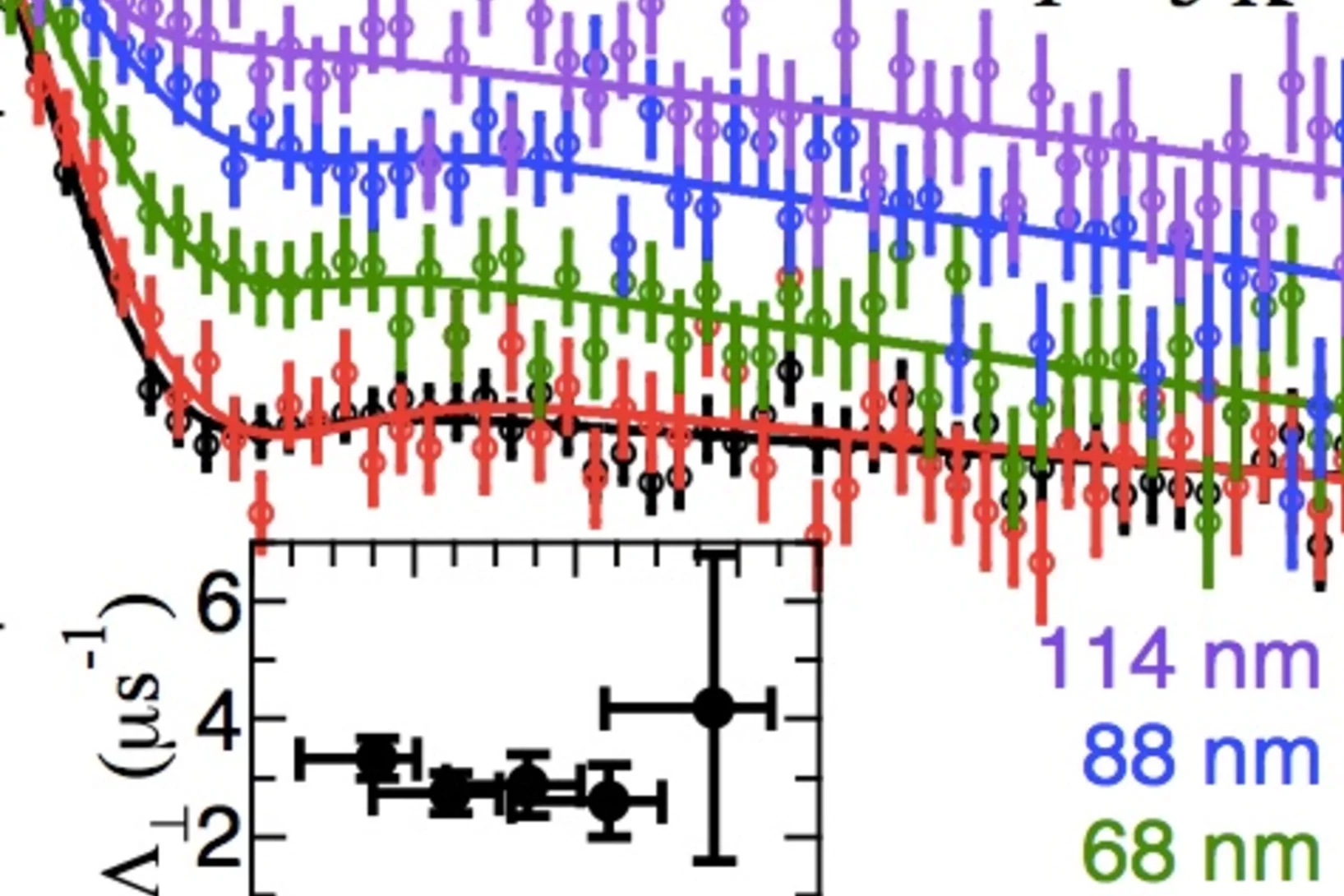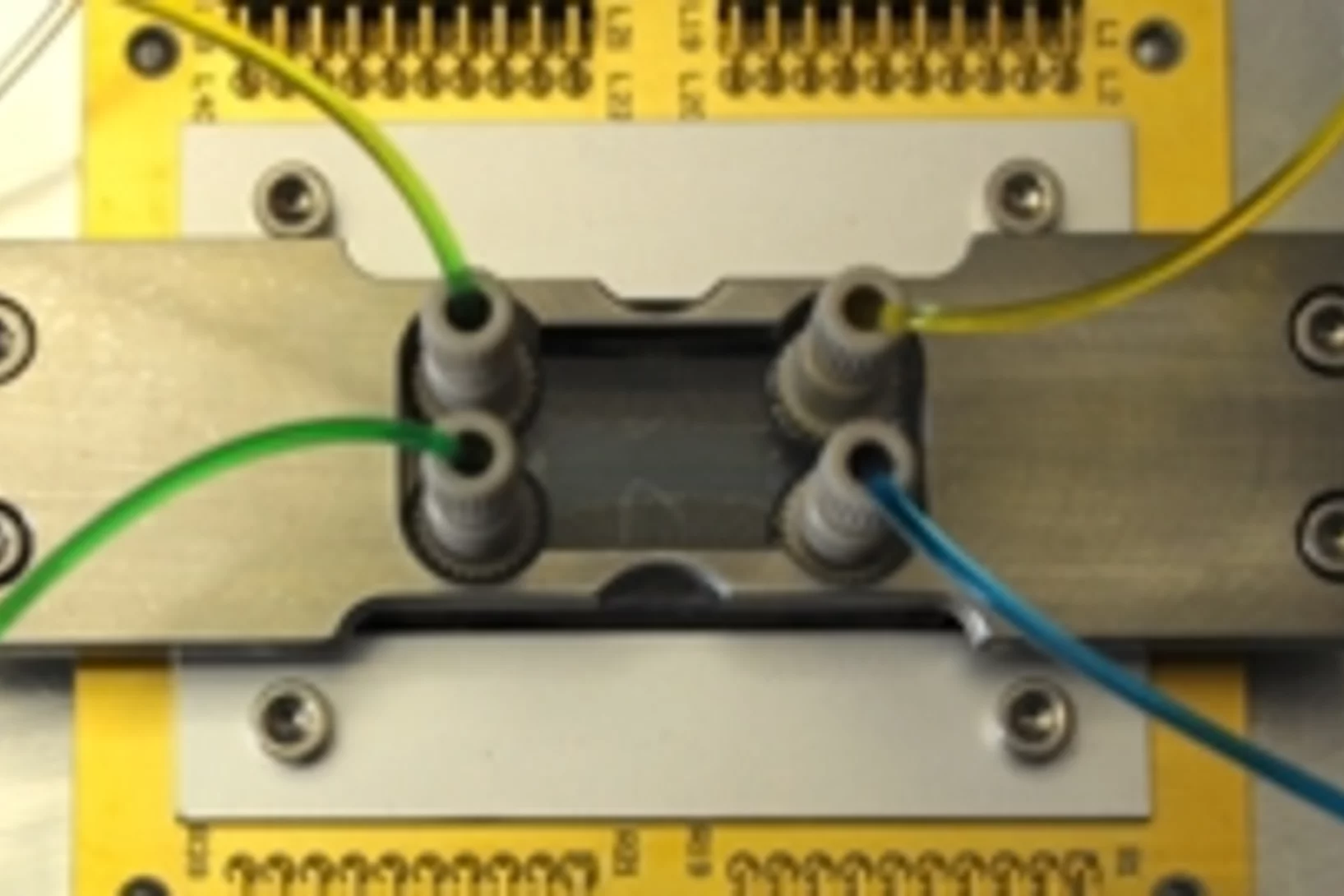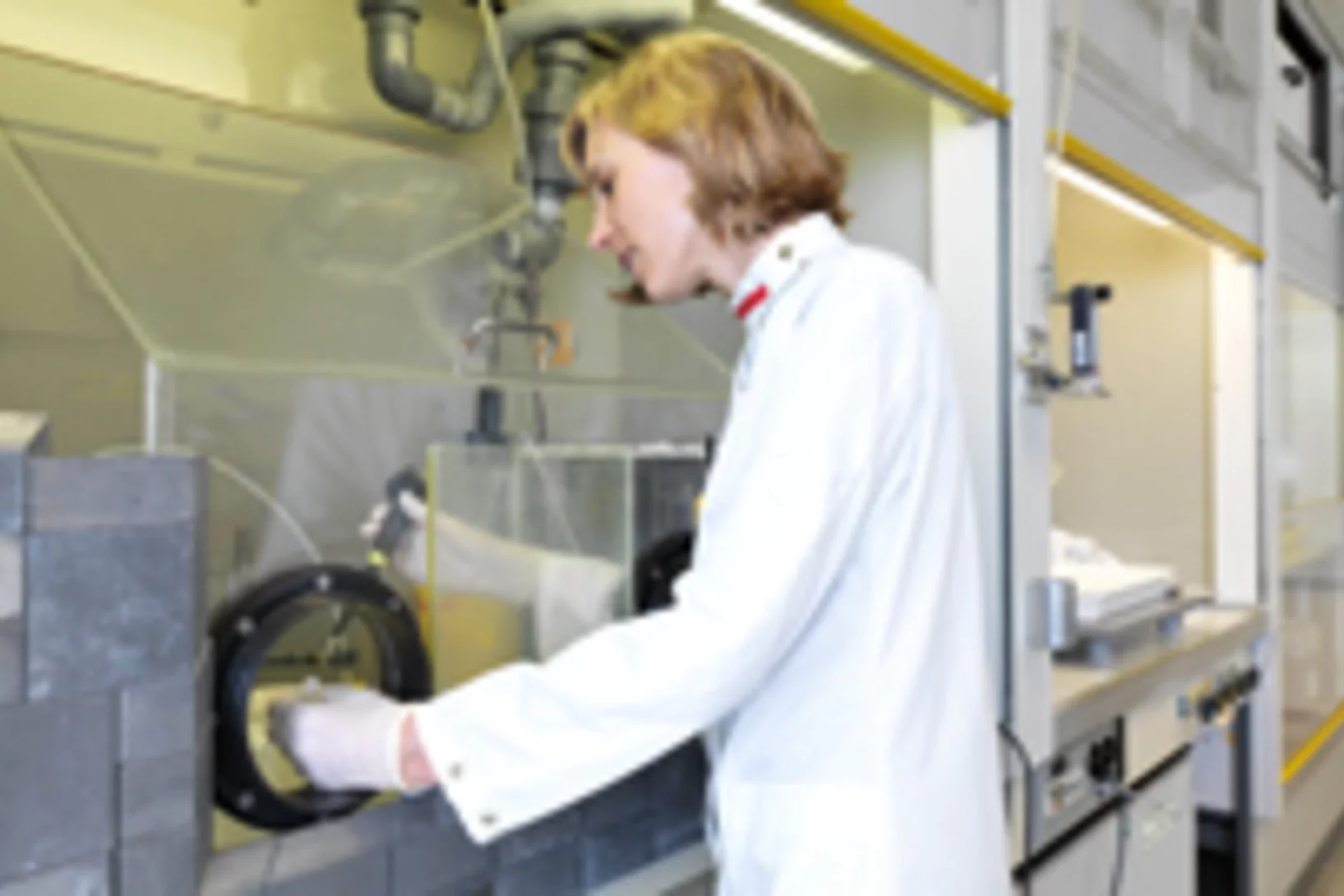A l’Institut Paul Scherrer, les scientifiques cherchent des réponses à la question essentielle des structures élémentaires de la matière et des principes fondamentaux de fonctionnement dans la nature. Ils étudient la structure et les propriétés des particules élémentaires – les plus petits composants de la matière – ou se penchent sur la question de savoir comment les molécules biologiques sont structurées et remplissent leur fonction. Les connaissances qu’ils acquièrent de la sorte ouvrent de nouvelles pistes de solution en sciences, en médecine ou dans le domaine des technologies.
Pour en savoir plus, reportez-vous à Aperçu Fondements de la nature
Reaction Conditions of Methane-to-Methanol Conversion Affect the Structure of Active Copper Sites
Determining the structure of the active Cu sites, which are associated with the methane conversion intermediate during stepwise, low-temperature, methane-to-methanol conversion, represents an important step for the upgrade of this reaction route to a viable process. Quick X-ray absorption spectroscopy allowed us to follow the electronic and structural changes to the active Cu sites during reaction with methane and during desorption of the activated intermediate. A large fraction (41%) of the oxygen-activated CuII reacted with methane and underwent reduction to CuI.
Bulk superconductivity in undoped T'-La1.9Y0.1CuO4 probed by muon spin rotation
The Meissner effect has been directly demonstrated by depth-resolved muon spin rotation measurements in high-quality thin films of the T'-structured cup rate, T'-La1.9Y0.1CuO4, to confirm bulk superconductivity (Tc ≈ 21 K) in its undoped state. The gradual expelling of an external magnetic field is observed over a depth range of ∼ 100 nm in films with a thickness of 275(15) nm, from which the penetration depth is deduced to be 466(22) nm. Based on this result, we argue that the true ground state of the “parent” compound of the n-type cuprates is not a Mott insulator but a strongly correlated metal with colossal sensitivity to apical oxygen impurities.
Supraconductivité activée par un champ magnétique
Le plus souvent, on considère supraconductivité et champs magnétiques comme étant des concurrents : en effet, de façon générale, les champs magnétiques intenses brisent l’état supraconducteur. Des physiciens de l’Institut Paul Scherrer (PSI) ont montré récemment que dans le matériau CeCoIn5, un nouveau type d’état supraconducteur apparaissait en présence de forts champs magnétiques externes, et que ce nouvel état supraconducteur pouvait ensuite être manipulé en jouant avec ces champs. Ce matériau est déjà un supraconducteur à faible champ. Mais en présence de champs intenses, un second état supraconducteur différent apparaît.
Expériences au sein du nuage : l’influence de la suie sur le climat
Martin Gysel, chercheur au PSI, se voit remettre un prestigieux subside européen (ERC Consolidator Grant), pour mener des analyses sur le rôle de la suie au niveau de la formation des nuages et du réchauffement de l’atmosphère.
Promises of cyclotron-produced 44Sc as a diagnostic match for trivalent beta - emitters: In vitro and in vivo study of a 44Sc-DOTA-folate conjugate
Research Division Biology and Chemistry (BIO), Folate Receptor Targeting Group, Head Cristina Müller. In recent years, implementation of 68Ga-radiometalated peptides for PET imaging of cancer has attracted the attention of clinicians. Herein, we propose the use of 44Sc (half-life = 3.97 h, average β+ energy [Eβ+av] = 632 keV) as a valuable alternative to 68Ga (half-life = 68 min, Eβ+av = 830 keV) for imaging and dosimetry before 177Lu-based radionuclide therapy.
L’Institut Paul Scherrer dirige deux des pôles de compétence de la Confédération dans le domaine de l’énergie
Dans le cadre de la Stratégie énergétique 2050, la Confédération et le Parlement ont décidé de renforcer l’encouragement de la recherche énergétique en Suisse. Dans ce cadre, il est prévu de mettre sur pied sept pôles de compétence travaillant en réseau : les Swiss Competence Centers in Energy Research (pôles de compétence interuniversitaire en recherche énergétique ou SCCER). Des institutions du Domaine des EPF, des universités et des hautes écoles spécialisées (HES) devraient s’allier, au sein des SCCER, avec des partenaires industriels. Objectifs : constituer de nouvelles compétences, et mettre au point des solutions novatrices dans certains champs d’action décisifs pour le tournant énergétique. Dans deux SCCER à dévolus au stockage de l’énergie et à la biomasse à qui ont déjà obtenu leur adjudication, l’Institut Paul Scherrer (PSI) est l’institution responsable. Ils se mettront au travail dès 2014.
Un appareil infectieux à noyau métallique
Grâce à l'analyse d'échantillons de protéines menée au PSI, des chercheurs lausannois ont franchi une étape dans la compréhension des mécanismes de l'infection par un agent pathogène, permettant ainsi le développement de nouvelles thérapies pour lutter contre la transmission de certaines maladies.Des chercheurs de l'EPF Lausanne (EPFL) ont décrit avec une précision inégalée à ce jour les interactions protéiques impliquées dans l'infection pathogène et responsables de la transmission de certaines maladies. Les scientifiques emmenés par Petr Leiman, professeur assistant au Laboratoire de biophysique et de biologie structurelle de l'EPFL, ont identifié et caractérisé une protéine virale (appelée PAAR) jouant un rôle crucial lors de l'infection. Cette dernière, renfermant un atome de métal à son extrémité assurant sa rigidité, est responsable de la perforation de la cellule hôte, telle une aiguille. Ces éléments de connaissance se fondent sur des mesures effectuées à la Source de Lumière Suisse (SLS), l'un des trois grands instruments de recherche de l'Institut Paul Scherrer (PSI).
La membrane pour pile à combustible de l’Institut Paul Scherrer est meilleure que son pendant du commerce
Lors de tests de laboratoire, une membrane novatrice pour pile à combustible, développée à l’Institut Paul Scherrer (PSI), a démontré une plus longue durée de fonctionnement que son pendant disponible dans le commerce. La percée a été rendue possible grâce au traitement d’un synthétique bon marché par irradiation, suivi d’un « greffage » de précieux additifs. Le synthétique ainsi modifié tient plus longtemps, et pourrait réduire de 50% à 80% les coûts de fabrication de la membrane. Celle-ci pourrait être utilisée, par exemple, dans des piles à combustible à hydrogène, ou dans des électrolyseurs, pour produire de l’hydrogène à partir d’eau.
Comment le botox se lie aux cellules nerveuses
Le botox est un poison extrêmement dangereux, qui provoque des paralysies. En usage cosmétique, il est employé pour supprimer les rides, et en médecine pour traiter les migraines ou corriger le strabisme, par exemple. Une équipe de recherche vient de déterminer la façon dont la molécule de toxine se lie à la cellule nerveuse, bloquant ainsi son activité. Ces résultats pourraient s’avérer utiles pour le développement de meilleurs médicaments, avec lesquels le risque de surdosage serait moins important qu’aujourd’hui.
Une image plus nette d’un catalyseur et des ses aspérités
Le catalyseur au ruthénium sur support de carbone est couramment utilisé dans l’industrie. Exemple éminent : la synthèse d’ammoniac, qui sert notamment à la fabrication d’engrais azotés. L’objectif de nombreux groupes de chercheurs dans le monde est d’optimiser ce type de catalyseur, dans l’idée d’améliorer l’efficacité d’un procédé industriel, qui figure parmi les plus importants d’un point de vue économique. Mais jusqu’ici, les connaissances sur la manière dont se constituent les centres catalytiquement actifs dans le catalyseur restent lacunaires. Des chercheurs de l’Institut Paul Scherrer (PSI) ont à présent réussi à mettre à jour des éléments importants.
Zukünftige Computerchips mit "elektronischem Blutkreislauf"
Im Rahmen des Sinergia-Programms fördert der Schweizerische Nationalfonds das dreijährige Forschungsvorhaben REPCOOL. Unter der Leitung von IBM Research à Zürich arbeiten in diesem Projekt Wissenschaftler der ETH Zürich, des Paul Scherrer Instituts in Villigen und der Università della Svizzera italiana in Lugano gemeinsam an der Erforschung eines elektronischen Blutkreislaufs für zukünftige 3D-Computerchips. Vom menschlichen Gehirn inspiriert, entwickeln die Forscher ein Mikrokanalsystem mit einer elektrochemischen Flussbatterie, die 3D-Chipstapel gleichzeitig kühlen und mit Energie versorgen. Ultimatives Ziel ist die Entwicklung eines Supercomputers in PC-Grösse.Cette actualité n'existe qu'en allemand.
Elektronen mit „gespaltener Persönlichkeit“
Im supraleitenden Material La1.77Sr0.23CuO4 verhält sich oberhalb der Übergangstemperatur ein Teil der Elektronen wie in einem konventionellen Metall, ein anderer Teile wie in einem unkonventionellen à je nach Bewegungsrichtung. Das zeigen Untersuchungen an der SLS. Die Entdeckung dieser Anisotropie liefert einen wesentlichen Beitrag zum Verständnis der Hochtemperatursupraleitung. Ausserdem wird man diesen Effekt in zukünftigen Experimenten und Theorien berücksichtigen müssen.Cette actualité n'existe qu'en anglais et allemand.
SwissFEL – la machine : lumière laser par amplification en avalanche
SwissFEL produira des rayons X ayant les propriétés du laser. L’amplification en avalanche nécessaire à la génération de la lumière est possible grâce à un procédé connu sous le terme de Microbunching à Le paquet d’électrons se divise dans l’onduleur en minces rondelles, qui émettent la lumière en phase. Un deuxième processus est en cours d’étude actuellement à le Seeding à qui devra permettre d’améliorer les caractéristiques de la lumière avec plus de précision.
Unique insight into carbon fibers on the nanoscale
The investigation of the mechanical properties of carbon fibers benefits from highly resolved three-dimensional density maps within representative volumes, but such images are not easily obtained with standard methods. Scientists from the Paul Scherrer Institut in collaboration with Honda R&D in Germany have recently visualized density distributions on the sub-micrometer scale within entire carbon fiber sections, revealing surprising graphite distributions within the fibers. This capability will prove useful for the systematic characterization of fibers, contributing to the development of light and robust materials at lower costs.
Magnetismus im Stress: Gleichzeitiger Anti- und Ferromagnetismus
Die gleichzeitige Existenz von Magnetismus und Ferroelektrizät in einem Material ist selten. Setzt sich dieser Magnetismus aus mehreren unabhängigen, magnetischen Grundzuständen zusammen, ist das ungewöhnlich. Einer schweizerisch-französischen Zusammenarbeit unter Leitung des Paul Scherrer Instituts ist es gelungen, mehrere magnetische Grundzustände in einem Material zu realisieren und detailliert zu untersuchen.
Des cas rares de désintégration de particules appuient le modèle standard
A partir de données mesurées au détecteur CMS au CERN, des chercheurs de l’Institut Paul Scherrer ont observé pour la première fois, avec une certitude suffisante, le cas rare de la désintégration du méson Bs en deux muons. Ils ont également déterminé sa fréquence. Leurs résultats coïncident avec les prédictions du modèle standard de la physique des particules.
Interface superconductor with gap behaviour like a high-temperature superconductor
The physics of the superconducting state in two-dimensional (2D) electron systems is relevant to understanding the high-transition-temperature copper oxide superconductors and for the development of future superconductors based on interface electron systems. But it is not yet understood how fundamental superconducting parameters, such as the spectral density of states, change when these superconducting electron systems are depleted of charge carriers.
Neues Diagnoseverfahren bei Brustkrebs vielversprechend
Ein neues Mammografie-Verfahren könnte laut einer soeben veröffentlichten Studie einen deutlichen Mehrwert für die Diagnose von Brustkrebs in der medizinischen Praxis bringen. Die am PSI in Zusammenarbeit mit dem Brustzentrum des Kantonsspitals Baden und dem Industriepartner Philips entwickelte Methode macht bereits kleinste Gewebeveränderungen besser sichtbar. Dies könnte potenziell die Früherkennung von Brustkrebs verbessern. Zukünftig sollen Studien an Frauen mit einer Brustkrebserkrankung den Mehrwert der Methode endgültig belegen.Cette actualité n'existe qu'en anglais et allemand.
Mit Röntgenstrahlen der Lebensdauer von Lithium-Ionen-Akkus auf der Spur
Mithilfe von Röntgen-Tomographie haben Forschende die Vorgänge in Materialien von Batterie-Elektroden detailliert untersuchen können. Anhand hochaufgelöster 3D-Filme zeigen sie auf, weshalb die Lebensdauer der Energiespeicher begrenzt ist.Cette actualité n'existe qu'en anglais et allemand.
Helena Van Swygenhoven, chercheuse au PSI, est lauréate d’un prestigieux subside européen (ERC Grant)
Helena Van Swygenhoven, chercheuse en matériaux à l’Institut Paul Scherrer et professeure à l’EPF Lausanne (EPFL), obtient un ERC Advanced Grant. Ce subside prestigieux du Conseil européen de la recherche (ERC), d’un montant de 2,5 millions de francs, lui permettra de fonder le nouveau projet de recherche MULTIAX. Dans le cadre de ce dernier, elle étudiera des procédés de déformation dans certains matériaux métalliques, qui sont importants pour les processus de fabrication de pièces de voiture, par exemple. En outre, de nouveaux procédés d’étude des matériaux seront développés dans le cadre de ce projet, qui seront ensuite rendus accessibles également à d’autres chercheurs.
Die Ursprünge der ersten Fische mit Zähnen
Mit Hilfe von Röntgenlicht aus der Synchrotron Lichtquelle Schweiz des PSI ist es Paläontologen der Universität Bristol gelungen, ein Rätsel um den Ursprung der ersten Wirbeltiere mit harten Körperteilen zu lösen. Sie haben gezeigt, dass die Zähne altertümlicher Fische (der sogenannten Conodonten) unabhängig von den Zähnen und Kiefern heutiger Wirbeltiere entstanden sind. Die Zähne dieser Wirbeltiere haben sich vielmehr aus einem Panzer entwickelt, der dem Schutz vor den Conodonten, den ersten Raubtieren, diente.
Un aperçu de l’approvisionnement énergétique mondial à venir
En 2050, comment le monde s’approvisionnera-t-il en énergie, et quelles seront les conséquences sociales, économiques et écologiques de différents objectifs de développement et de différentes conditions-cadre politiques ? Ces questions, les chercheurs de l’Institut Paul Scherrer (PSI) y répondent en collaboration avec le Conseil Mondial de l’Énergie CME, en analysant deux scénarios : un premier qui mise principalement sur l’économie de marché, et un second principalement sur la régulation. Ces analyses sont aujourd’hui terminées, et leurs résultats seront présentés du 13 au 17 octobre, au Congrès mondial de l’Energie du CME, qui se tiendra à Daegu, en Corée du Sud.
De la vitamine pour lutter contre le cancer
Cristina Müller, membre du Centre des Sciences Radiopharmaceutiques, consacre sa recherche à un traitement, basé sur des liaisons d’acide folique marquées radioactivement. Ces liaisons pénètrent sans entrave dans la cellule, comme un cheval de Troie, avant de la tuer avec leurs radiations, explique-t-elle.
Formation de particules dans l'atmosphère: l'expérience CLOUD au CERN déchiffre un nouveau composant du processus
Les gouttelettes qui forment les nuages se constituent à partir de minuscules particules, qui planent dans l’atmosphère. On ignore encore beaucoup de choses sur la manière dont ces dernières se forment. Récemment, et pour la première fois, on a réussi à déchiffrer la formation de particules à partir d’amines et d’acide sulfurique. Une avancée majeure pour la recherche en sciences atmosphériques.
La sécurité – une culture à développer
Sabine Mayer dirige depuis le début de cette année la Division Radioprotection et Sécurité (ASI) de l’Institut Paul Scherrer (PSI). Cette physicienne est responsable de la coordination de l’ensemble de la sécurité au PSI, du corps des sapeurs-pompiers de l’institut à la surveillance radiologique, en passant par la sécurité au travail. Mais l’importance de sa division s’étend au-delà du PSI : les autorités suisses font souvent appel à ses experts, qui participent ainsi également au développement de la culture de la sécurité en Suisse.
Une désintégration décisive
Un processus extrêmement rare devrait déterminer quelle sera, à l’avenir, la théorie la plus adéquate pour décrire notre univers. Ce processus, c’est une désintégration bien particulière d’un type de particule élémentaire : les muons. Ces particules ne vivent guère longtemps et se désintègrent en d’autres particules différentes. Alors qu’un modèle théorique interdit pratiquement un processus bien particulier de désintégration des muons, un autre modèle théorique l’autorise. Quelle théorie est la bonne ? Des physiciens de l’Institut Paul Scherrer ont fait un pas en avant dans cette énigme, grâce à l’observation extrêmement précise de plusieurs centaines de milliards de désintégrations. Ils ont publié leurs résultats dans la revue spécialisée « Physical Review Letters ».
Vers des batteries à base d’ions de sodium
Comprendre la dynamique du sodium au niveau microscopiqueLes batteries lithium-ions sont très, mais l'utilisation du lithium a des inconvénients : c'est un élément coûteux, dont l'extraction a un impact environnemental. Pour construire une batterie sodium-ions, il faut donc comprendre comment les ions de sodium se déplacent dans les matériaux concernés. Des chercheurs de l'Institut Paul Scherrer ont à présent déterminé, pour la première fois, les voies qu'empruntent les ions de sodium dans un matériau susceptible d'être utilisé pour une batterie. Ces connaissances permettent maintenant de réfléchir au moyen de créer de nouveaux matériaux présentant des propriétés nécessaires aux futures batteries, grâce à une légère modification de la structure ou de la composition.
Simulations informatiques : un pilier essentiel de la sécurité des centrales nucléaires
Sans simulations informatiques, l’exploitation de centrales nucléaires serait pratiquement impossible. Qu’il s’agisse d’intégrer de nouveaux composants, ou de mener des tests et des essais visant à assurer la sécurité : presque tout doit être calculé et analysé par ordinateur au préalable. Au Laboratoire de physique des réacteurs et des comportements des systèmes, on développe à cet effet des modèles de calcul et des programmes informatiques. Les chercheurs du PSI officient dans ce cadre en tant que partenaires de recherche indépendants de l’IFSN (Inspection fédérale de sécurité nucléaire), et fournissent ainsi une contribution importante pour assurer la sécurité des centrales nucléaires suisses.
Des billes pour moins de déchets nucléaires
L’idée de produire du combustible nucléaire sous forme de sphères (et non de pastilles, comme c’est l’usage aujourd’hui) remonte aux années 1960. Les avantages suivants en étaient escomptés : une simplification de la fabrication du combustible ainsi qu’une nette réduction de la quantité de déchets radioactifs lors de sa fabrication et de son utilisation en centrale nucléaire. Ce type de combustible n'a toutefois jamais été utilisé parce que les types de réacteurs pour lesquels il avait été envisagé n’ont pas pu s'imposer. Dans le passé, l’Institut Paul Scherrer (PSI) a aussi contribué à la recherche en matière de combustible à particules sphériques. A nouveau, plusieurs projets, en partie financés par l’Union européenne, sont actuellement en cours au PSI. Leur objectif : continuer à améliorer la production des billes de combustible. Cette forme de combustible pourrait être utilisée soit dans des installations spéciales de réduction des quantités de déchets radioactifs, soit dans des réacteurs rapides de quatrième génération, qui, en cycle fermé, produisent eux aussi moins de déchets à vie longue.
Décrypter les techniques de fabrication de l’âge du bronze grâce aux neutrons et à la lumière synchrotron
Des analyses menées au PSI ont permis de déterminer le mode de fabrication d'une hache de l'âge du bronze exceptionnelle. Un résultat rendu possible grâce au procédé de la tomographie neutronique, qui permet de produire une image 3D de l'intérieur d'un objet. Le PSI collabore avec succès depuis une décennie avec différents musées et institutions archéologiques, en Suisse et à l'étranger. Signe tangible de cette coopération bien établie : le PSI accueille pendant toute une journée le 18e Congrès international des bronzes antiques, organisé du 3 au 7 septembre 2013 à l'Université de Zurich.






























